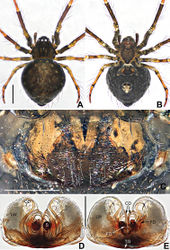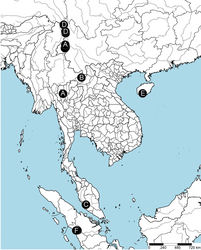Coddingtonia lizu
| Notice: | This page is derived from the original publication listed below, whose author(s) should always be credited. Further contributors may edit and improve the content of this page and, consequently, need to be credited as well (see page history). Any assessment of factual correctness requires a careful review of the original article as well as of subsequent contributions.
If you are uncertain whether your planned contribution is correct or not, we suggest that you use the associated discussion page instead of editing the page directly. This page should be cited as follows (rationale):
Citation formats to copy and paste
BibTeX: @article{Feng2019ZooKeys886, RIS/ Endnote: TY - JOUR Wikipedia/ Citizendium: <ref name="Feng2019ZooKeys886">{{Citation See also the citation download page at the journal. |
Ordo: Araneae
Familia: Theridiosomatidae
Genus: Coddingtonia
Name
Coddingtonia lizu Feng & Lin, 2019 sp. nov. – Wikispecies link – ZooBank link – Pensoft Profile
Type material
Holotype ♀, paratypes 2♀ and 2 juv. ♂ (NHMSU) CHINA: Hainan Province, Sanya City, Baoting County, Maogan Town, Xian’an Stone Cave, 18°35.86'N, 109°25.61'E, ca. 620 m, 24 Nov. 2014, F. Li et al. leg. Two paratypes 1 juv. ♂ and 1♀ used for sequencing, same data as for preceding, GenBank: MN211313 and MN211312.
Etymology
Named for the Lizu people, an ethnic minority that first settled in the Hainan Province. Noun in apposition.
Diagnosis
This new species can be distinguished from the congeners by having 5 loops of unilateral copulatory duct (Fig. 5D; Note: the broken first and fourth loops on the right side of copulatory duct in vulva are due to careless dissection). Moreover, it has a posterior tubercle on the abdomen (Fig. 5A, B), which is absent in C. anaktakun, C. discobulbus, and C. huifengi sp. nov. (Fig. 2A–D; Labarque and Griswold 2014[1]: figs 5A–C, 6A–C, 7A–C).
Description
Female (holotype): Carapace pear-shaped, black. Sternum dim, posteriorly contracted. Femora and tibiae of legs dark, other segments yellow to brown. Abdomen dark black, dorsal color lighter than venter, with posterior tubercle, covers sparse long, stiff setae (Fig. 5A, B). Measurements: Total length 1.72. Carapace 0.64 long, 0.61 wide. Clypeus 0.13 high. Sternum 0.40 long, 0.38 wide. Abdomen 1.23 long, 1.05 wide. Length of legs: I 2.06 (0.66, 0.26, 0.43, 0.39, 0.32); II 1.84 (0.56, 0.23, 0.38, 0.35, 0.32); III 1.42 (0.43, 0.19, 0.26, 0.29, 0.25); IV 1.81 (0.56, 0.23, 0.41, 0.34, 0.27).
Epigyne (Fig. 5C–E): weakly sclerotized, nearly rectangular, black pigmentation in the central region; central pit and lateral pockets indistinct. lateral wings well developed, reniform and translucent; spermathecae small and round, separated by approximately one radius; copulatory ducts form a posterolateral auricular loop on the both sides of the lateral wings, followed by 5 loops, and finally connecting ventrally on the spermathecae (Fig. 5D); fertilization ducts short, arise from the dorsal-inner base of spermathecae (Fig. 5E).
Male. unknown.
Distribution
Known only from the type locality (Fig. 6).
Original Description
- Feng, C; Lin, Y; 2019: Three new species of the genus Coddingtonia from Asia (Araneae, Theridiosomatidae) ZooKeys, 886: 113-126. doi
Images
|
Other References
- ↑ Labarque F, Griswold C (2014) New ray spiders from Southeast Asia: the new Philippine genus Tagalogonia gen. nov. and continental genus Coddingtonia Miller, Griswold and Yin, 2009 (Araneae: Theridiosomatidae), with comments on their intergeneric relationships. In: Williams G Gosliner T (Eds) The Coral Triangle: The 2011 Hearst Philippine Biodiversity Expedition.California Academy of Sciences, San Francisco, 407–425.


